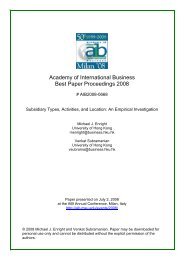AIB 2012 Conference Proceedings - Academy of International ...
AIB 2012 Conference Proceedings - Academy of International ...
AIB 2012 Conference Proceedings - Academy of International ...
You also want an ePaper? Increase the reach of your titles
YUMPU automatically turns print PDFs into web optimized ePapers that Google loves.
TUESDAY<br />
<strong>of</strong> the EMNE's internationalization as the EMNE firm generally lacks firm specific ownership advantages (FSAs).<br />
In this respect, the extent literature has not addressed a gap that if the EMNE lacks FSAs and internationalize to<br />
augment assets, then what factors enables the EMNE to internationalise to augment assets. While examining<br />
asset augmentation activities <strong>of</strong> the EMNE undertaken through cross border merger and acquisitions, we find<br />
that the EMNE having absorptive capacity and financial capability internationalize to procure technological<br />
assets through acquisitions. (For more information, please contact: Surender Munjal, University <strong>of</strong> Leeds and<br />
University <strong>of</strong> Delhi, United Kingdom: smu@lubs.leeds.ac.uk)<br />
Which Factors Determine the Acquisition Price <strong>of</strong> Cross-border Acquisitions: Do Emerging Market Multinationals<br />
Pay More for their Targets in Advanced Economies<br />
Dieter Somers, Katholieke Universiteit Leuven<br />
Filip De Beule, KU Leuven<br />
This paper examines which factors have an impact on the acquisition price and investigates whether emerging<br />
market multinationals pay on average more for their takeovers in advanced economies than their counterparts<br />
from developed markets. This study also contributes to the literature by analyzing whether emerging market<br />
multinationals pay more for vertically related target firms or target firms that are active in high-tech industries.<br />
After a linear regression with robust standard errors, we obtain surprising results. The empirical analysis<br />
confirms that emerging market multinationals pay more for their targets in advanced economies. Our analysis<br />
however also shows that emerging market multinationals are paying a lower acquisition price when their targets<br />
are vertically related or are active in high-tech industries. These last two findings contradict our hypotheses.<br />
(For more information, please contact: Dieter Somers, Katholieke Universiteit Leuven, Belgium:<br />
dieter.somers@econ.kuleuven.be)<br />
Sequential <strong>International</strong>ization, Heterogeneous Process and Subsidiary Roles: The Case <strong>of</strong> Hyundai Motor<br />
Company<br />
Chung-Sok Suh, University <strong>of</strong> New South Wales<br />
Yue Wang, University <strong>of</strong> New South Wales<br />
Myung Hyun Nahm, Hannam University<br />
This paper proposes a new two-phase conceptualization <strong>of</strong> firm internationalization, combining routes to foreign<br />
production as the first phase and subsidiary development as the second phase. Focusing on modeling the<br />
second phase, we theorize alternative routes <strong>of</strong> subsidiary development and establish conceptual links between<br />
firm internationalization and subsidiary roles in relation to patterns <strong>of</strong> knowledge flows. The model is<br />
illustrated through a comprehensive analysis <strong>of</strong> a concrete empirical case. We demonstrate that the overall<br />
internationalization process <strong>of</strong> Hyundai Motor Company (HMC), especially the company's accelerated<br />
engagement in foreign production since the 1990s, shows both a sequential pattern from the headquarters'<br />
perspective and heterogeneous development at the subsidiary level. At the headquarters, the rationale <strong>of</strong><br />
capability-building through sequential investment links the company's strategies toward its overseas<br />
subsidiaries. Learning from its initial entry failure, HMC adapted its investment strategy to build production<br />
subsidiaries in countries where the company enjoyed firm-specific advantages (FSA) over local competitors and<br />
faced a low degree <strong>of</strong> liability <strong>of</strong> foreignness (LOF) before moving further into markets where HMC faced less<br />
FSA and a higher degree <strong>of</strong> LOF. At the subsidiary level, however, the HMC experience shows a<br />
heterogeneous development <strong>of</strong> overseas subsidiaries, which led to individual subsidiaries playing different roles<br />
and shaping the knowledge-flow patterns within the company's global operations. (For more information, please<br />
contact: Chung-Sok Suh, University <strong>of</strong> New South Wales, Australia: c.suh@unsw.edu.au)<br />
<strong>AIB</strong> <strong>2012</strong> <strong>Conference</strong> <strong>Proceedings</strong><br />
Page 212

















